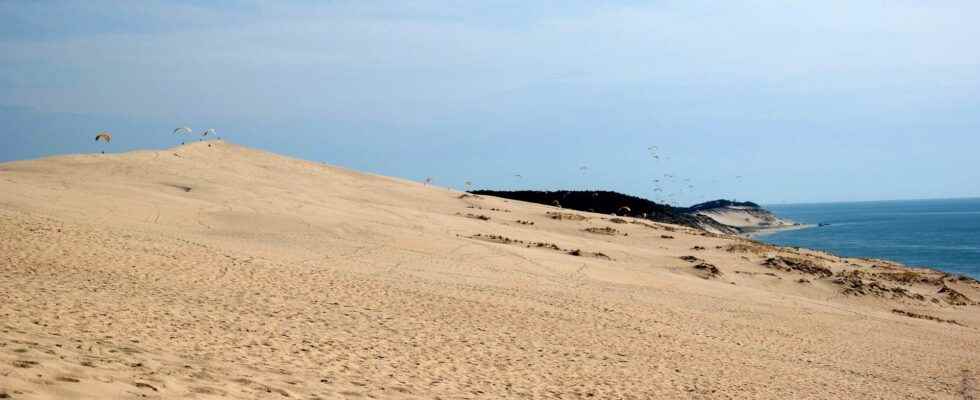You will also be interested
[EN VIDÉO] Beachgrass, the grass that stabilizes coastal dunes Established in the past on the coast in the Landes and in the Nord department with the aim of stabilizing the dunes, the marram grass is a grass adapted to drought. The rolling of its leaves, furnished with small hairs, reduces evaporation, therefore the loss of water. Its rhizomes hold it very well in loose soil and are also reserves for the plant. © MNHN
More than 106 meters high and 616 meters wide: these are the dimensions of the highest dune in Europe ! Enough to make you dizzy and feel like you’re in the middle of the desert, if you nevertheless manage to ignore the dense vegetation below. The Dune du Pilat is thus one of the most emblematic natural curiosities in France. Located at the exit of the Arcachon basin, this impressive accumulation of fine sand borders the Atlantic coast for nearly three kilometers in length. Ranked among the Great Sites of France and popular with tourists, the Dune du Pilat is a constantly evolving sitewhich has a long history behind it.
It was not built in a day, or even in a few months. Its formation dates back more than 6,000 years, as evidenced by certain rocks that compose it.
A dune in evolution for 6,000 years
Because on closer inspection, we realize that this dune is not only composed of sand. The side overlooking the ocean is indeed marked by the presence of dark layers alternating with sand levels. These are paleosols, which represent the remains fossils old floors. In addition to being able to be dated, these levels are extremely rich in information which provides information on the environmental conditions at the time of their formation. They may thus contain remains of shellsarchaeological remains but also bioturbations, which are marks left by small organisms such as certain worms and shells and which make it possible to better constrain the paleoenvironment.
Four paleosols are thus visible in the Dune du Pilat and provide information on its formation. The first has been dated to 3,800 BC. The second dates from around 2,980 BC, the third has been dated to the XIe in the XIIIe century thanks to the discovery of numerous archaeological remains (fragments of pottery, heaps of shells, etc.). The last paleosol corresponds to the top of the Dune de la Grave and is located at an altitude of 20 to 70 meters above sea level. This small dune is now covered with vegetation. This last formation is in a way the ancestor of the Pilat dune.
In 1883, it was the Grave dune that was mapped, with a mention in 1887, by a certain M. Clavel, of the ” formation of a new dune that engulfs under the sand of the 15-meter high pine forests “. The Pilat dune is then gaining height.
Coastal drift, geometry of the Arcachon basin and winds: the ingredients for the Pilat dune
The origin of the Pilat dune is to be found under water. Indeed, the dune is mainly linked to the sea currents which transport sand along the Atlantic coast. We are talking about a north-south drift. This very powerful phenomenon displaces large quantities of marine sediments, including sand, along the French Atlantic coasts. It is linked to the predominance of winds coming from the northwest in this region, which will create a swell impacting the coast with a southeasterly direction. This results in a current parallel to the coast, the littoral drift, moving south. This current is notably responsible for the formation of the Banc d’Arguin, a vast accumulation of sand which currently faces the Dune du Pilat and represents its sand reservoir.
The Banc d’Arguin however owes its existence to the morphology particular of Arcachon bay. Indeed, without the presence of this large lagoon, which interrupts the coastal strip, the sand would have continued its migration towards the south. The regular emptying of the basin and its filling at each tide disturb the littoral drift and prevent it from carrying the sand further south. This will then settle and accumulate over the millennia at the outlet of the basin.
Then it’s up to the wind to do its job. The alternations of seasons and the winds associated with it gradually transported the small grains of sand to the coast located just opposite the Banc d’Arguin, forming different successive dunes, until the magnificent Pilat dune was obtained.
The Dune du Pilat can be visited freely. However, it should not be forgotten that this is a classified and protected natural area, which should be respected.
Reading ideas for the summer with Futura?
To celebrate the start of the holidays, we offer you the Mag Futura at the preferential price of 15 € instead of 19 €, i.e. a reduction of 20% !
What is Mag Futura?
- Our first paper journal of more than 200 pages to make science accessible to as many people as possible
- 4 major scientific questions for 2022, from the Earth to the Moon
- Home delivery*
*Special offer valid until July 19. Delivery is made in France (excluding metropolitan France), Switzerland, Belgium.
Interested in what you just read?
